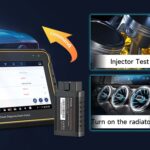For anyone running a small business with a fleet of vehicles, or even just managing a personal car, unexpected repairs can be a major headache and expense. As someone who wasn’t initially a “car guy,” I quickly learned that mastering basic car maintenance and diagnostics myself was crucial for survival in this business. That’s where the Ancel Jp700 Obd2 scanner became an indispensable tool. Purchased for around $60, this scanner proved its worth within just three days of arrival, and it continues to pay dividends.
Just a day after receiving the ANCEL JP700, the check engine light illuminated on one of our cars. Within minutes, I was able to plug in the scanner, read the error code, and use a quick online search to pinpoint the issue. A short YouTube tutorial later, a $15 part was ordered from Amazon. The next day, after the part arrived, the repair was completed swiftly and efficiently. This scenario has repeated itself countless times since then. The combination of an OBD-II code and the internet is truly empowering, offering self-reliance and a wealth of options for car maintenance. Even if DIY repairs aren’t your forte, understanding the error codes and doing some preliminary research before visiting a mechanic puts you in a much stronger position.
Beyond simply reading engine codes, the ANCEL JP700 also boasts a surprisingly effective battery test function. In fact, it outperforms a more expensive dedicated battery tester I had previously invested in. Furthermore, the live data stream capability is incredibly valuable for monitoring vehicle performance and diagnosing more complex problems.
It’s important to address some of the negative feedback I’ve seen about this scanner, as they often stem from misunderstandings about what a tool in this price range can and should do. Some users seem to expect a comprehensive, vehicle-specific diagnosis right out of the box. While the ANCEL JP700 does provide a generic database of potential causes for each error code, it is not designed to be a high-end, all-in-one solution. For detailed, specific information, a more expensive and complex professional-grade scanner would be necessary. However, for the average user, the JP700 provides exactly what’s needed: a starting point. Simply take the code provided by the ANCEL JP700, search online with your car’s year, make, and model, and you’ll find a wealth of information and guidance.
Another common complaint revolves around clearing codes. Some users clear a code with the scanner, only to have it reappear the next day, leading them to believe the scanner is faulty. It’s crucial to understand that no OBD2 scanner, including the ANCEL JP700, is designed to fix the underlying mechanical issue causing the error code. The scanner’s job is to identify the problem, not solve it. Repairing the issue that triggered the code is the user’s responsibility.
Finally, concerns about durability have been raised, with some reporting the device breaking after a short period. While the ANCEL JP700 is reasonably robust for its price point, it’s not indestructible. Abuse, like stepping on it or using it as a tool, will likely damage it. However, in my experience, the ANCEL JP700 is built to last under normal usage. Mine has been in service for three years now, used multiple times a month, dropped on concrete floors more times than I can count, and generally lives unsecured in my trunk or backseat. Despite this rough treatment, it has never failed to perform reliably.
In conclusion, the ANCEL JP700 OBD2 scanner is an outstanding investment for anyone looking to take control of their car maintenance and repair costs. It provides essential diagnostic capabilities in an affordable, user-friendly package. Highly recommended for both DIY enthusiasts and those who simply want to be informed car owners.
